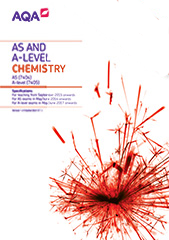AS practical assessment
Practical work is at the heart of chemistry, so we have placed it at the heart of this specification.
Assessment of practical skills in this AS specification will be by written exams only.
The practical endorsement does not apply to the AS specification. A rich diet of practical work is essential to develop students' manipulative skills and understanding of the processes of scientific investigation. It also contributes to teaching and learning of the concepts within this specification.
Questions in the papers have been written in the expectation that students have carried out at least the 6 required practical activities in section 7.2.
15% of the marks in the papers will relate to practical work.
Use of apparatus and techniques
All students taking this specification are expected to have carried out the required practical activities in section 7.2. These develop skills in the use of many of the following apparatus and techniques. This list is a compulsory element of the full A-level course. It is reproduced here for reference and to aid co-teaching the AS and A-level specifications.
Apparatus and techniques |
|
|---|---|
AT a |
Use appropriate apparatus to record a range of measurements (to include mass, time, volume of liquids and gases, temperature) |
AT b |
Use water bath or electric heater or sand bath for heating |
AT c |
Measure pH using pH charts, or pH meter, or pH probe on a data logger |
AT d |
Use laboratory apparatus for a variety of experimental techniques including:
|
AT e |
Use volumetric flask, including accurate technique for making up a standard solution |
AT f |
Use acid–base indicators in titrations of weak/strong acids with weak/strong alkalis |
AT g |
Purify:
|
AT h |
Use melting point apparatus |
AT i |
Use thin-layer or paper chromatography |
AT j |
Set up electrochemical cells and measuring voltages |
AT k |
Safely and carefully handle solids and liquids, including corrosive, irritant, flammable and toxic substances |
AT l |
Measure rates of reaction by at least two different methods, for example:
|
Required practical activities
Updated
The following practicals must be carried out by all students taking this course. Written papers will assess knowledge and understanding of these, and the skills exemplified within each practical.
Required activity |
Apparatus and technique reference |
|---|---|
| 1 Make up a volumetric solution and carry out a simple acid–base titration |
a, d, e, f, k |
|
2 Measurement of an enthalpy change |
a, d, k |
|
3 Investigation of how the rate of a reaction changes with temperature |
a, b, k |
4 Carry out simple test-tube reactions to identify:
|
d, k |
| 5 Distillation of a product from a reaction |
b, d, k |
|
6 Tests for alcohol, aldehyde, alkene and carboxylic acid |
b, d, k |
Teachers are encouraged to vary their approach to these practical activities. Some are more suitable for highly structured approaches that develop key techniques. Others allow opportunities for students to develop investigative approaches.
This list is not designed to limit the practical activities carried out by students. A rich practical experience for students will include more than the 6 required practical activities. The explicit teaching of practical skills will build students’ competence. Many teachers will also use practical approaches to the introduction of content knowledge in the course of their normal teaching.
Practical skills to be assessed in written papers
Overall, at least 15% of the marks for all AS Chemistry courses will require the assessment of practical skills.
In order to be able to answer these questions, students need to have been taught, and to have acquired competence in, the appropriate areas of practical skills as indicated in the tables of coverage below.
Independent thinking
Practical skill |
|
|---|---|
PS 1.1 |
Solve problems set in practical contexts |
PS 1.2 |
Apply scientific knowledge to practical contexts |
Use and application of scientific methods and practices
Practical skill |
|
|---|---|
PS 2.1 |
Comment on experimental design and evaluate scientific methods |
PS 2.2 |
Present data in appropriate ways |
PS 2.3 |
Evaluate results and draw conclusions with reference to measurement uncertainties and errors |
PS 2.4 |
Identify variables including those that must be controlled |
Numeracy and the application of mathematical concepts in a practical context
Practical skill |
|
|---|---|
PS 3.1 |
Plot and interpret graphs |
PS 3.2 |
Process and analyse data using appropriate mathematical skills as exemplified in the mathematical appendix for each science |
PS 3.3 |
Consider margins of error, accuracy and precision of data |
Instruments and equipment
Practical skill |
|
|---|---|
PS 4.1 |
Know and understand how to use a wide range of experimental and practical instruments, equipment and techniques appropriate to the knowledge and understanding included in the specification |
